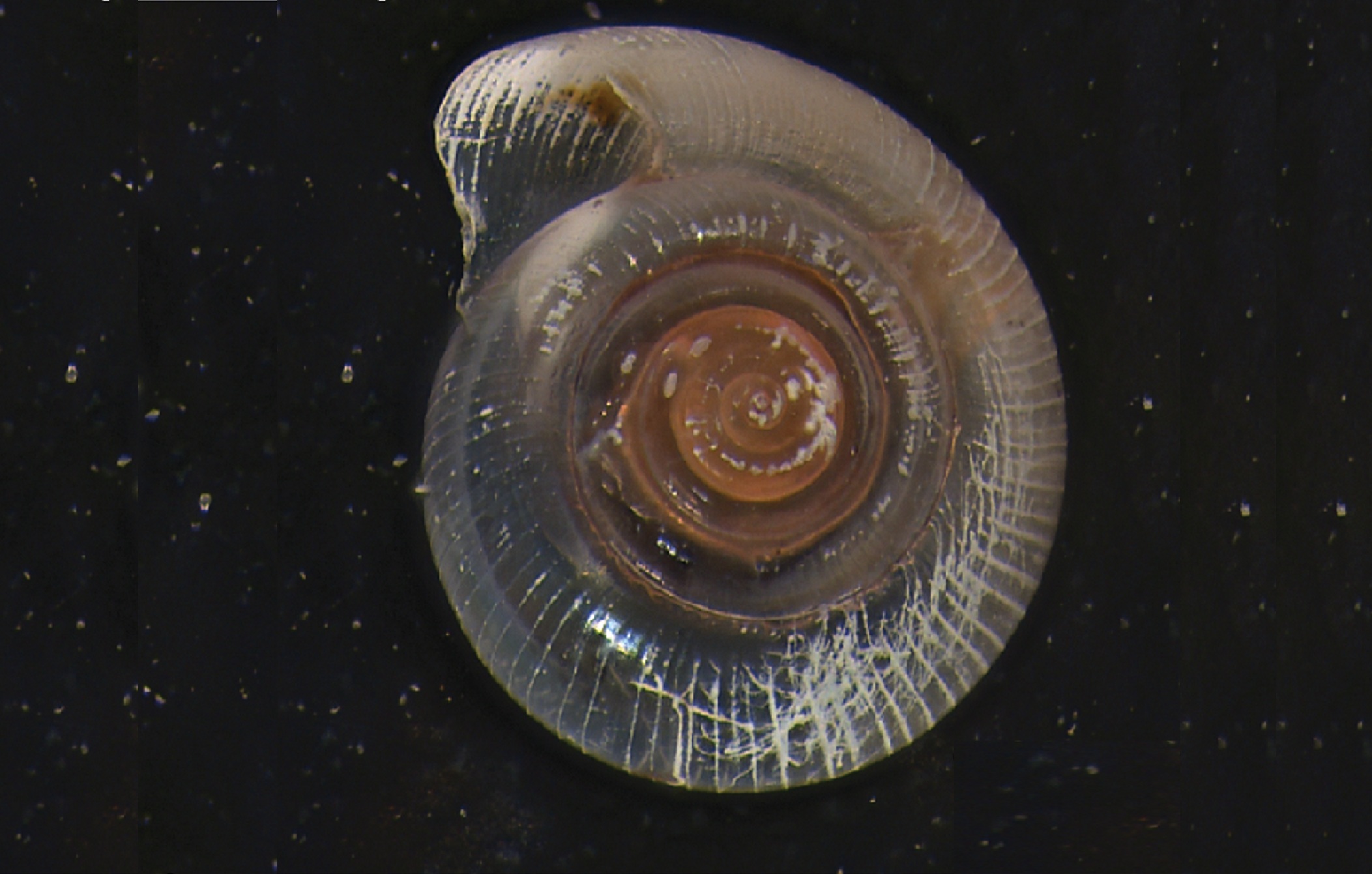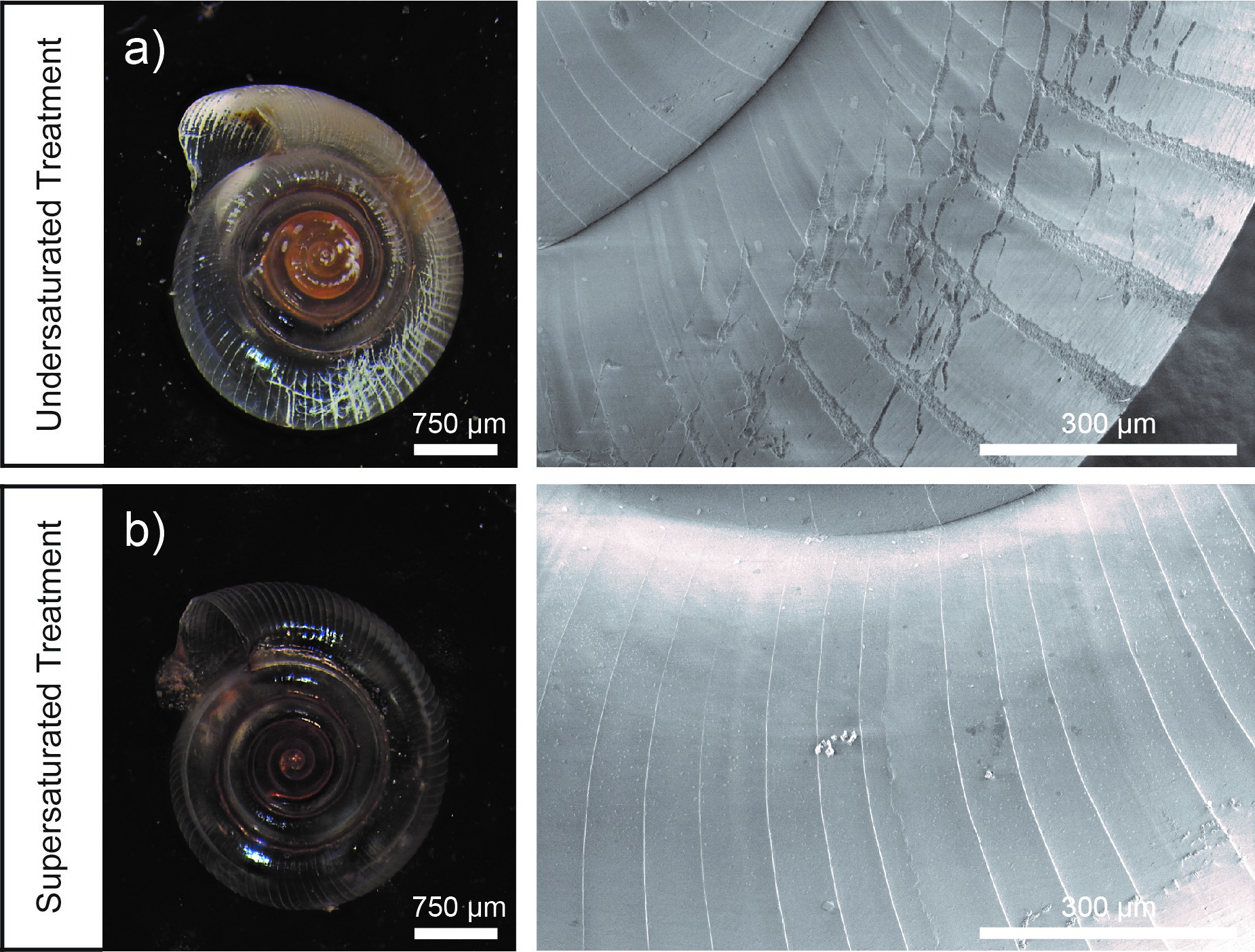Questioning the pteropod's status as a key bioindicator for the effects of ocean acidification

by Nicole Crozier
As the ocean continues to become more acidic due to the absorption of ever-increasing amounts of anthropogenic carbon dioxide from the air, effective bioindicator species are key to anticipating future consequences of climate change. For the past decade, pteropods, also known as sea butterflies, have widely been considered an excellent bioindicator for the effects of ocean acidification. However, new research by UVic PhD student Matt Miller is putting the pteropod’s status as an effective bioindicator into question.
In a new study published in the ICES Journal of Marine Science, Miller has demonstrated that the pteropod shell may not be as vulnerable to dissolving in acidic conditions as previously thought. His results show that a protective coating of proteins on the shell, the periostracum, protects the shell from dissolving in acidic water.
Pteropods have been considered a key bioindicator because we thought that their shell was extremely soluble in acidic conditions. Our study has found that the shell is actually protected by the periostracum—only areas of the shell where the periostracum was damaged showed any signs of dissolution."
- Matt Miller, PhD student in Earth and Ocean Sciences
His findings have the potential to shake up the ocean acidification community.
Pteropods are tiny planktonic snails that live in the ocean all over the world. They create their shells by drawing the mineral calcium carbonate from the waters of their environments. Currently, it’s believed that the pteropod’s shell easily dissolves in acidic conditions. As the ocean acidifies, the amount of available carbonate decreases, making it thermodynamically favourable for the pteropod shell to dissolve, returning carbonate to the water. The crystal form of pteropod’s calcium carbonate shells, called aragonite, differs from that of most shelled organisms, making the shell ~50 % more soluble in seawater. Thus, it’s thought that pteropods will feel the consequences of ocean acidification before many other species in the marine ecosystem.
While this explanation of pteropod shell dissolution has been widely accepted, it never completely made sense to UVic Earth and Oceans Sciences professor John Dower, Miller’s PhD supervisor.
“Pteropods have been around for centuries and have survived in extremely acidic environments in the past. Pteropods are also currently surviving in regions that are more acidic, such as the Salish Sea. This reality seems to indicate that pteropods have an unknown mechanism to be resilient to changes in ocean chemistry,” explains Dower.
In 2016, researchers put forth evidence that the periostracum, a thin layer of proteins found on the outer layer of the shell of all shelled molluscs, might offer pteropods protection from shell dissolution. This was a contentious finding, and after reading scientific papers from both sides of the debate, Miller decided to run his own experiment and make his own conclusions.
To test the protective nature of the periostracum, Miller intentionally damaged a small area of the periostracum of pteropods from the Salish Sea. The pteropods were then incubated in acidic conditions, where the water was undersaturated with respect to aragonite, or in non-acidic conditions, where the water was supersaturated with respect to aragonite.
"When examining the shells post-incubation, we found that shells only dissolved when exposed to aragonite undersaturated water (the acidic condition), and only where the periostracum had been damaged. This is strong evidence that the periostracum protects the shell from dissolution in acidic conditions," says Miller.

Miller’s findings help to explain how pteropods have managed to deal with natural exposures to more acidic water during previously high CO2 periods and survived in regions with naturally acidic waters—their shells were protected by the periostracum. The findings go against the widely accepted belief that pteropods are extremely susceptible to shell dissolution in acidic environments. Miller and Dower are both hesitant to prescribe exactly what this finding will mean for pteropod’s status as a bioindicator for the effects of ocean acidification, however.
Typically, the most vulnerable groups are used as bioindicators, as they will be the first group to be affected by changes. It’s therefore important for us to know if pteropods are really as vulnerable as we think, and this research is indicating that they may not be. We may not be able to use shell dissolution as an indicator of ocean acidification, but is there another aspect of the pteropod’s biology that makes it vulnerable? We don’t currently know enough about the basic biology of pteropods to have a definitive answer to that."
- John Dower, Earth and Ocean Sciences professor
Miller is also quick to dispel the idea that his research indicates that pteropods are immune to climate change and ocean acidification.
“While the periostracum may protect pteropods from shell dissolution, there are other stressors that may still pose threats to their survival. For example, the progression of ocean acidification will increase the energetic costs required to create a shell or for other metabolic processes,” he says.
While Miller and Dower wait to see the reaction of the pteropod community to their new paper, Evidence for an effective defence against ocean acidification in the key bioindicator pteropod Limacina helicina, they’re continuing their work on pteropods and ocean acidification. Their next project involves the largest analysis to date of the vertical distribution of pteropods in the ocean and what that means for their exposure to ocean acidification.
Miller’s research was supported by funding from the Natural Sciences and Engineering Research Council and the Government of Canada’s Aquatic Climate Change Adaptation and Services Program.
